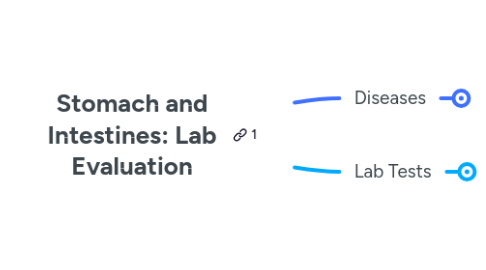
1. Diseases
1.1. H. Pylori
1.1.1. Biopsy
1.1.1.1. Positive Culture?
1.1.1.1.1. pH change
1.1.2. Breath test
1.1.2.1. Breath in
1.1.2.1.1. 13C-labeled urea
1.1.2.2. Monitor breath for
1.1.2.2.1. 13C-labeled CO2
1.1.2.3. Sensitivity 94%
1.1.2.4. Specificity 95 %
1.1.3. IgG
1.2. Zollinger-Ellison Syndrome
1.3. Gastritis, Pernicious anemia
1.3.1. Gastritis
1.3.1.1. Acute
1.3.1.1.1. Transient
1.3.1.1.2. Caused by
1.3.1.2. Chronic
1.3.1.2.1. H. Pylori
1.3.1.2.2. Autoimmune Chronic Gastritis
1.3.1.2.3. Chemical Gastropathy
1.3.1.2.4. Inflammatory processes leading to
1.3.1.3. Labs
1.3.1.3.1. Achlorhydria / hypochlorhydria
1.4. Malabsorption
1.4.1. Characterized by
1.4.1.1. amylorrhea
1.4.1.1.1. excess starch
1.4.1.2. Steatorrhea
1.4.1.2.1. Excess fat
1.4.1.3. Creatorrhea
1.4.1.3.1. Meat fibers, protein
1.4.2. May be due to
1.4.2.1. Pancreatic dieases
1.4.2.1.1. Chronic pancreatitis
1.4.2.1.2. Carcinoma
1.4.2.1.3. Cystic Fibrosis
1.4.2.1.4. Trauama
1.4.2.2. ZES
1.4.2.3. Liver disease with blockage of bile flow
1.4.2.4. Intestinal diseases
1.4.2.4.1. Celiac disease
1.4.2.4.2. Crohn's disease
1.4.2.4.3. Whipple's disease
1.4.2.4.4. Lymphoma
1.4.2.4.5. Intestinal resection
1.4.2.4.6. Blind loop syndrome
1.4.2.4.7. Carcinoid Syndrome
1.4.3. Treatment
1.4.3.1. Resin
1.4.3.1.1. Bile-acid sequestering agents
1.4.4. Fat Malabsorption
1.4.4.1. Fecal fat excretion
1.4.4.1.1. Quantiative
1.4.4.1.2. Qualitative
1.4.4.2. Fat malabsoprtion
1.4.4.2.1. Fecal Fat determination
1.4.4.2.2. 14C-triolein breath test
1.4.4.3. Serum Beta-Carotene levels
1.4.4.3.1. Beta-carotene is fat soluble precursor to vitamin A
1.4.4.3.2. Adequately present in most diets
1.4.4.3.3. Decreased serum levels suggest fat malabsoprtion
1.4.4.3.4. Can't make Vitamin A if you can't absorb Ffat
1.4.4.4. Other Labs affected by Malabsorption
1.4.4.4.1. Serum calcium
1.4.4.4.2. Serum ALP
1.4.4.4.3. Serum Proteins
1.4.4.4.4. Serum Urea nitrogen
1.4.4.4.5. Hypocholesterolemia
1.4.4.4.6. Prothrombin Time
1.4.4.4.7. Glucose
1.4.4.4.8. Vitamin A
1.5. Colorectal cancer
1.5.1. Screening
1.5.1.1. FOBT
1.5.1.2. Guaiac Test
1.5.1.2.1. Presence of Heme in feces catalyzes oxidation of guaiac
1.5.1.2.2. Three consecutive stools should be sampled
1.5.1.2.3. False Negatives
1.5.1.2.4. False Positives
1.5.2. Confirmatory Test
1.5.2.1. Blood - Tumor Markers
1.5.2.1.1. CEA - Carcinoembryonic antigen CEA
1.5.2.1.2. CA19-9
1.5.2.2. Colonoscopy - Tumor Tissue
1.5.2.2.1. MSI - Microsatellite instability
1.5.2.2.2. Oncogene BRAF mutation
1.5.2.2.3. Tumor suppressor gene mutations
1.5.2.2.4. Tumor M2-PK
1.6. Diarrhea
1.6.1. Acute Diarrhea
1.6.1.1. Evaluation of Acute Diarrhea
1.6.1.1.1. Schema 2
1.6.1.1.2. Schema 1
1.6.2. Chronic Diarrhea
1.6.2.1. Evaluation of Chronic Diarrhea
1.6.2.1.1. Rule out
1.6.2.1.2. Fecal Calprotectin and Lactoferrin
1.6.2.1.3. Endoscopy with mucosal biopsy
1.6.3. Pathophysiologic Mechanisms
1.6.3.1. 1. Decreased absorption of fluid and electrolytes
1.6.3.2. 2. Increased secretion of fluids and electrolytes
1.6.4. Frequent Passage of Loose watery stool
1.6.4.1. Exudative Diarrhea
1.6.4.1.1. Blood and pus present in stool
1.6.4.1.2. Inflammatory bowel diseases
1.6.4.1.3. Severe infections
2. Lab Tests
2.1. Fecal occult blood
2.2. Gastrin and Secretin
2.2.1. Serum Gastrin levels are used to diagnose
2.2.1.1. Zollinger-Ellison Syndrome
2.2.1.1.1. Pathophysiology
2.2.1.1.2. Testing Algorithm
2.2.1.2. Autoimmune Gastritis
2.2.1.3. Pathophysiology of Hypergastrinemia
2.2.1.3.1. Markedly increased gastric acid secretion
2.2.1.3.2. Increased gastric acid output leads to
2.2.1.3.3. Increased acid in intestine leads to
2.2.2. Secretin Stimulation Test
2.2.2.1. Measures ability of the pancreas to respond to secretin
2.2.2.2. Normal
2.2.2.2.1. Secretin ↓ Gastrin
2.2.2.3. Confirmatory Test
2.2.2.3.1. Gastrinoma / ZES
2.2.2.4. May be abnormal in
2.2.2.4.1. Pancreatic diseases
2.2.2.5. Secretin
2.2.2.5.1. Secreted by
2.2.2.5.2. Stimulated by
2.2.2.5.3. Stimulates
2.3. Gastric Acid Testing
2.3.1. Measurements
2.3.1.1. Initial Resting / Basal measurement
2.3.1.1.1. amt. HCl produced by stomach under basal / fasting conditions, without exposure to visual, auditory, olfactory stimuli (cephalic digestion I guess)
2.3.1.2. Maximal stimulation follows basal measurement
2.3.2. Demographics
2.3.2.1. Young > Old
2.3.2.2. M > F
2.3.3. Decreased in
2.3.3.1. gastric carcinoma
2.3.3.2. gastric ulcer
2.3.3.3. females
2.3.3.4. aging persons
2.3.4. Hyperacidity (Increased) in
2.3.4.1. dudodenal ulcer
2.3.4.2. jejunal ulcer
2.3.5. Achlorhydria
2.3.5.1. pernicious anemia
2.3.5.2. advanced carcinoma of the stomach
2.3.5.3. Other anemias
2.3.5.3.1. hypochromic anemia
2.3.5.3.2. aplastic anemia
2.3.5.3.3. hypothyroidism
2.3.5.3.4. nutritional megaloblastic anemia
2.4. Schilling Test
2.4.1. B12 Deficiency Test
2.4.2. Absorption of B12 is measured
2.4.2.1. Orally administered radio-labeled B12
2.4.2.2. quantitated by its appearance in the urine
2.4.2.2.1. >8% excretion
2.4.2.2.2. < 7% excretion
2.4.3. B12
2.4.3.1. essential cofactor
2.4.3.1.1. DNA synthesis
2.4.3.2. Absorption
2.4.3.2.1. intrinsic factor
2.4.3.2.2. Ileum
2.4.3.3. Deficiency
2.4.3.3.1. Decreased IF
2.4.3.3.2. Decreased absorption
